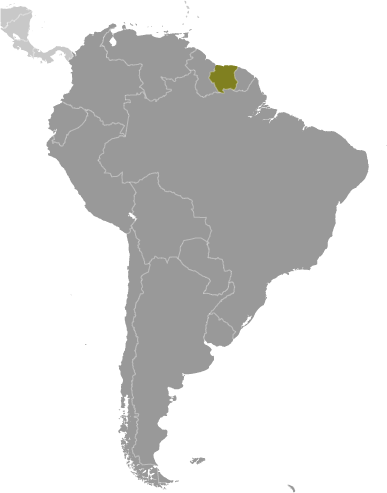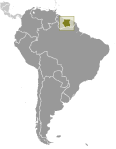
|
|
Advertisements:
People And SocietyNationality
Noun Surinamer(s)
Adjective Surinamese Ethnic groups
Hindustani (also known locally as "East Indians"; their ancestors emigrated from northern India in the latter part of the 19th century) 37%, Creole (mixed white and black) 31%, Javanese 15%, "Maroons" (their African ancestors were brought to the country in the 17th and 18th centuries as slaves and escaped to the interior) 10%, Amerindian 2%, Chinese 2%, white 1%, other 2% Languages
Dutch (official), English (widely spoken), Sranang Tongo (Surinamese, sometimes called Taki-Taki, is native language of Creoles and much of the younger population and is lingua franca among others), Caribbean Hindustani (a dialect of Hindi), Javanese Religions
Hindu 27.4%, Protestant 25.2% (predominantly Moravian), Roman Catholic 22.8%, Muslim 19.6%, indigenous beliefs 5% Population World Ranking: 170
560,157 (July 2012 est.)
Age structure
0-14 years
26.4% (male 66,440/female 63,469) 15-64 years 67.3% (male 164,739/female 166,139) 65 years and over 6.3% (male 13,300/female 17,902) (2011 est.) Median age
Total 27.6 years
Male 27.3 years Female 28 years (2012 est.) Population growth rate World Ranking: 96
1.222% (2012 est.)
Birth rate World Ranking: 110
17.44 births/1,000 population (2012 est.) Death rate World Ranking: 159
6.17 deaths/1,000 population (July 2012 est.) Net migration rate World Ranking: 56
0.96 migrant(s)/1,000 population (2012 est.) Urbanization
Urban population 69% of total population (2010)
Rate of urbanization 1.5% annual rate of change (2010-15 est.) Major cities - population
PARAMARIBO (capital) 259,000 (2009) Sex ratio
At birth 1.05 male(s)/female
Under 15 years 1.04 male(s)/female 15-64 years 1.03 male(s)/female 65 years and over 0.77 male(s)/female Total population 1.01 male(s)/female (2011 est.) Maternal mortality rate World Ranking: 63
130 deaths/100,000 live births (2010) Infant mortality rate World Ranking: 70
Total 28.94 deaths/1,000 live births
Male 33.62 deaths/1,000 live births Female 24.03 deaths/1,000 live births (2012 est.) Life expectancy at birth World Ranking: 142
Total population 71.12 years
Male 68.78 years Female 73.58 years (2012 est.) Total fertility rate World Ranking: 119
2.08 children born/woman (2012 est.) Health expenditures World Ranking: 63
7.6% of GDP (2009)
Physicians density
0.45 physicians/1,000 population (2000) Hospital bed density
3.1 beds/1,000 population (2007) Hiv/aids - adult prevalence rate World Ranking: 49
1% (2009 est.)
Hiv/aids - people living with hiv/aids World Ranking: 123
3,700 (2009 est.)
Hiv/aids - deaths World Ranking: 103
Fewer than 200 (2009 est.)
Major infectious diseases
Degree of risk High
Food or waterborne diseases Bacterial and protozoal diarrhea, hepatitis A, and typhoid fever Vectorborne disease Dengue fever, Mayaro virus, and malaria Water contact disease Leptospirosis (2009)Education expenditures
NA
Literacy
Definition
Age 15 and over can read and write Total population 89.6%Male 92% Female 87.2% (2004 census) School life expectancy (primary to tertiary education)
Total 13 years (2006)
Unemployment, youth ages 15-24 World Ranking: 47
Total 21.5% (2004)
Comments
Add a new comment: |
Advertisement
Members area
Suriname (Paramaribo):
 
GPS points from Suriname (Paramaribo)
|
||||||||

 First explored by the Spaniards in the 16th century and then settled by the English in the mid-17th century, Suriname became a Dutch colony in 1667. With the abolition of slavery in 1863, workers were brought in from India and Java. Independence from the Netherlands was granted in 1975. Five years later the civilian government was replaced by a military regime that soon declared a socialist republic. It continued to exert control through a succession of nominally civilian administrations until 1987, when international pressure finally forced a democratic election. In 1990, the military overthrew the civilian leadership, but a democratically elected government - a four-party coalition - returned to power in 1991. The coalition expanded to eight parties in 2005 and ruled until August 2010, when voters returned former military leader Desire BOUTERSE and his opposition coalition to power.
First explored by the Spaniards in the 16th century and then settled by the English in the mid-17th century, Suriname became a Dutch colony in 1667. With the abolition of slavery in 1863, workers were brought in from India and Java. Independence from the Netherlands was granted in 1975. Five years later the civilian government was replaced by a military regime that soon declared a socialist republic. It continued to exert control through a succession of nominally civilian administrations until 1987, when international pressure finally forced a democratic election. In 1990, the military overthrew the civilian leadership, but a democratically elected government - a four-party coalition - returned to power in 1991. The coalition expanded to eight parties in 2005 and ruled until August 2010, when voters returned former military leader Desire BOUTERSE and his opposition coalition to power.